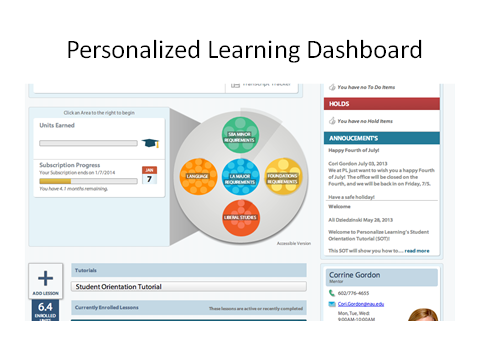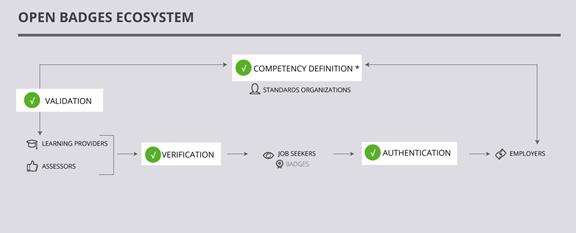Key Takeaways
- Extending low-cost, quality educational opportunities was the focus of the recent "Badges to Breakthroughs" panel session at EDUCAUSE 2013.
- Here, session participants offer individual summaries of their views on positioning MOOCs, exploring personalized learning, and examining how badges can provide value in the stakeholder ecosystem.
- Taken together, their perspectives illustrate the many breakthroughs occurring that both activate learner potential and validate alternative learning credentials.
Deborah Everhart is director of Solutions Strategy, Blackboard, Inc.; Fred Hurst is senior vice president at Northern Arizona University; and Ellen Wagner is executive director for WICHE/WCET.
In the From Badges to Breakthroughs: Unleashing Learner Potential through Competency-Based Achievements panel session at EDUCAUSE 2013, various presenters explored challenging innovations related to prior learning assessments, badge frameworks, and verification of competencies as options for extending low-cost, quality educational opportunities for increasingly diverse student and instructor populations.
Here, we present an overview of three of those presentations. First, Ellen Wagner, executive director of the Western Interstate Commission for Higher Education's Cooperative for Education Technologies (WICHE/WCET), noted that any discussion of educational breakthroughs in postsecondary education needed to acknowledge the catalytic role of MOOCs for reframing the discussion around flexible learning, but that so many other sessions featured MOOCs our intention was to acknowledge them and to move on to other innovations, including personalized learning, competency-based education, and badges as alternative credentials. Next, Fred Hurst, senior VP at Northern Arizona University, explains the structure and goals of the school's Personalized Learning program. Finally, Deborah Everhart illustrates how badges can provide value within complex stakeholder ecosystems. These diverse perspectives offer numerous insights into real-world breakthroughs for alternative learning credentials.
MOOCs as a Catalyst
Ellen Wagner
Despite Sebastian Thrun's recent epiphany that MOOCs aren't quite the answer for free education that he had hoped, MOOCs remain a huge catalyst for creativity in postsecondary education. They have certainly helped legitimize online learning; they have sparked realizations that learning experiences come in all shapes and sizes, and that course completion might not be the only end goal. In 2013, MOOC-as-community overtook MOOC-as-course. That is, the "hotness" of MOOCs is now less about the MOOCs themselves and more about the fact that they have shown us that we can all be a lot more creative about how we develop distributed, online learning experiences and how we engage with our wide variety of stakeholders.
WCET helped produced a MOOC on badges as currency for credentials; even though the MOOC's course components completed in October 2013, people continued to register so they could access the library of resources on issues such as badges for tracking progress, how to encourage completion of badge requirements, and how to validate badge system components. Interest in the topic and content extended well beyond the normal parameters for a course offering, and MOOC organizers were struck by people registering for the experience well after the "course" had concluded. As the MOOC has moved into its next iteration, the community connections and opportunities to learn and collaborate together continue to drive significant value.
Personalized Learning at Northern Arizona University
Frederick M. Hurst
Northern Arizona University's Personalized Learning is a competency-based, self-paced online learning program that enables motivated students to earn a high-quality degree more efficiently and at a lower cost by customizing coursework to fit their individual learning styles and previously acquired knowledge. The student experience starts before admission with a readiness assessment that helps the student and the university determine the student's suitability and preparation for the program. If students have gaps in preparation, NAU gives them specific developmental modules at no cost and no obligation. If a student doesn't understand probability, for example, the module addresses only probability.
Students in the Personalized Learning bachelor-degree programs in computer information technology, small business administration, and liberal arts work with a mentor faculty member before enrolment to develop a personalized learning plan to help them successfully achieve a life, work, and school balance. Once students are enrolled, they talk with their mentors at least once a week for the first six months. In subsequent subscriptions, students and their faculty mentor work out an appropriate level of contact. The curriculum is interdisciplinary and prescribed — there are no electives.
To develop the programs, the lead faculty deconstructed regular three-credit-hour NAU courses and reconstructed the learning outcomes and competencies into one- to 12-credit-hour lessons. Most of the materials are open educational resources (OER), with digital library and publisher content, as well as custom-developed resources. The lead faculty are responsible for curating the courses and finding new resources when multiple students have difficulty with a given concept. When students complete all the requirements for a traditional three-credit course, it is automatically displayed on a standard transcript, and the competencies are posted to a competency report designed so that employers can fully understand the competencies obtained.
Once enrolled, students complete a pre-assessment for each course and can test out of parts — or, in rare cases, all — of a class. Each target concept has multiple modalities including multimedia, lectures, documentaries, games, and simulations. Students decide when they are ready to complete the post-assessment, which might include a project, paper, or test. The minimum score to satisfactorily complete a course is 86 percent. Students who do not achieve the minimum score do not fail the class, but rather continue to work on the concepts they did not understand. All students must complete an internship or service-learning component for degree completion.
Students can start the program any day of the year with a subscription period of six months. They can complete as many courses or parts of courses as they want in that time period. The $2,500 cost is all-inclusive, with no extra cost for texts, other materials, technology, or university fees. Federal financial aid is available.
The soft launch of the Personalized Learning programs occurred in June 2013; full student recruiting commenced in January 2014. Our first-year goal of 500 students is on track, with a projected total of 8,000 within five years.

Badges: New Currency for Professional Credentials
Deborah Everhart
No badge is an island. Open badges work within a complex ecosystem.

To understand why and how badges can be an effective component in higher education, we need to define how badges attain value. Blackboard, Mozilla, Sage Road, and WCET have provided a framework for understanding how badges attain value and currency, particularly for learners who become job seekers. Our collaborative MOOC, "Badges: New Currency for Professional Credentials," explores how value is established, validated, and exchanged; for example, courses, credits, and credentials are already well-understood "currency" systems in our educational ecosystems, but how do we understand what it takes for badges to become a recognized currency?
To build this understanding, we analyze how badges work in an ecosystem of interrelated and interdependent stakeholders and processes. The model of the open badges ecosystem and how its components function in learning communities is highly adaptable to different types of institutions and different goals for badge implementation — in fact, we're finding that this analysis is highly applicable to various types of alternative credentials.
Traditionally, we view three principal sets of stakeholders as having a fairly simplistic, linear relationship: higher education institutions and other types of learning providers impart knowledge and skills to learners and issue credentials. Learners cum job seekers take their credentials to employers, who evaluate their relatively opaque transcripts.
When badges are introduced, we decouple learning providers and competency/skill assessment and add assessors as another set of stakeholders. Badges are tied to assessment and incorporate transparent definitions of competencies; badges are awarded when an individual demonstrates or provides evidence of competence. Learning providers can also be assessors, but these roles and processes can be differentiated.
Badge system collaboration among standards organizations, learning providers, assessors, and employers can benefit all stakeholders: When badges are tied to assessments that are themselves aligned with industry standards, the likelihood of finding the right match between job seeker and employer improves greatly. Learning providers can use these alignments to offer credentials that better match employer requirements and offer greater value to their learners. If the ecosystem is balanced in this way, the exchange value of badges is high.
For additional context and specific guidance for applying concrete analysis to your own ecosystem, see the Open Badges MOOC, "Badges: New Currency for Professional Credentials."
Conclusion
These topics are evolving rapidly as competency-based learning, personalized learning, and badges converge as methodologies for education that is more affordable, efficient, and effective. The potential is strong for unleashing breakthroughs that empower learners and encourage lifelong learning. For more background, the recording of the full presentation, From Badges to Breakthroughs: Unleashing Learner Potential through Competency-Based Achievements, is available on the EDUCAUSE 2013 Annual Conference site.
© 2014 By Deborah Everhart, Frederick M. Hurst, and Ellen Wagner. This work is licensed under the Creative Commons Attribution-NonCommercial-ShareAlike 4.0 International License.
